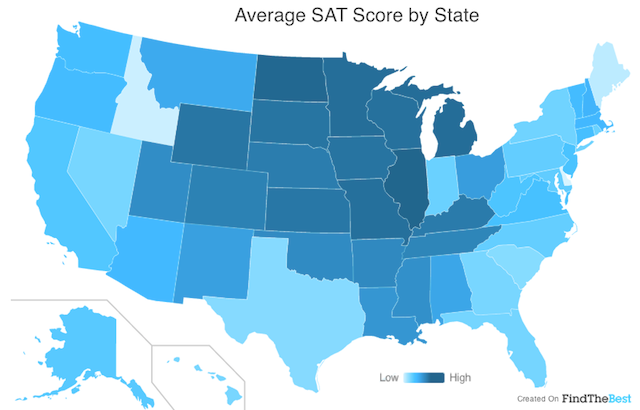If you break down SAT scores by state, you'll find that the Midwest outperforms the rest of the country—and it's not close. Illinois has the highest average score (1807*), while North Dakota (1799), Michigan (1782), Minnesota (1780), Missouri (1773) and Wisconsin (1771) round out the top five. Meanwhile, Idaho finishes last (1364), while Maine (1380) and South Carolina (1436) round out the bottom three.
*All scores are out of 2400 and are from 2013. Note that the SAT will be re-scored out of 1600 starting this year. For reference, the national average score in 2013 was 1498.
So are students in the Midwestern states simply smarter (or even better test takers) than their coastal counterparts? I started by looking at data on other national, standardized tests to see if there was a pattern.
First, for comparison, here's the heatmap of SAT scores by state, where darker is the higher average score:
The Midwest and surrounding states dominate the SAT.
Next is a map showing student performance on the National Assessment of Educational Progress (NAEP), a standardized test taken by fourth-, eighth-, and twelfth-graders across the country. Let's start with fourth grade.
Minnesota is still doing well, but the trend is clearly not there.
By eighth grade, northern states tend to do a little better than southern states, but again, there's nothing particularly special about the Midwest here.
Finally, here's a map showing performance on the college entrance exam alternative to the SAT, the ACT.
Again, the Midwest (as a whole) is no better than average.
So the Midwest rules the SAT, but apparently, no other test. And it gets even weirder: the SAT is not popular in the Midwest, where almost everyone takes the ACT. So how does the Midwest do so well on a test that many of its residents don't even bother to take?**
**Of course, about 20% of students across America end up taking both the SAT and ACT, but it's much more common to choose just one or the other. In the Midwest, this option is usually the ACT.
The most likely answer: only the best students take the Midwest SAT.
Why; For starters, the ~20% of students who take both the SAT and ACT are often the most ambitious. Don't like your score on an exam? Take the alternative and see if you can get a higher percentile. In the Midwest, the SAT is often a backup test for perfectionists—students who want to exhaust every possible option before submitting their college applications. Less motivated students are much more likely to take the ACT once and then leave standardized tests behind.
Then consider the difference between the Midwest's hundreds of regional schools and its handful of national universities.
With most of the smaller Midwest colleges, we see something very typical of the region: less than 20% of students submit SAT scores. For these institutions, a decent performance on the ACT is all that is needed.
Instead, students applying to such as Washington University in Saint Louis, Northwestern and the University of Chicago they typically look at top universities across the nation, from Stanford to Berkeley to the Ivy Leagues. Because the SAT is much more popular (and in some cases, expected) on the coasts, these students will take the SAT much more often than their regionally oriented peers.
In the end, this likely means that a typical state-by-state comparison of average SAT scores is misleading—more a study of sampling bias than a true accounting of each state's test-taking performance. The Midwest may be winning in points per tryout, but the reality is: all but the best players are still watching from the bench.

